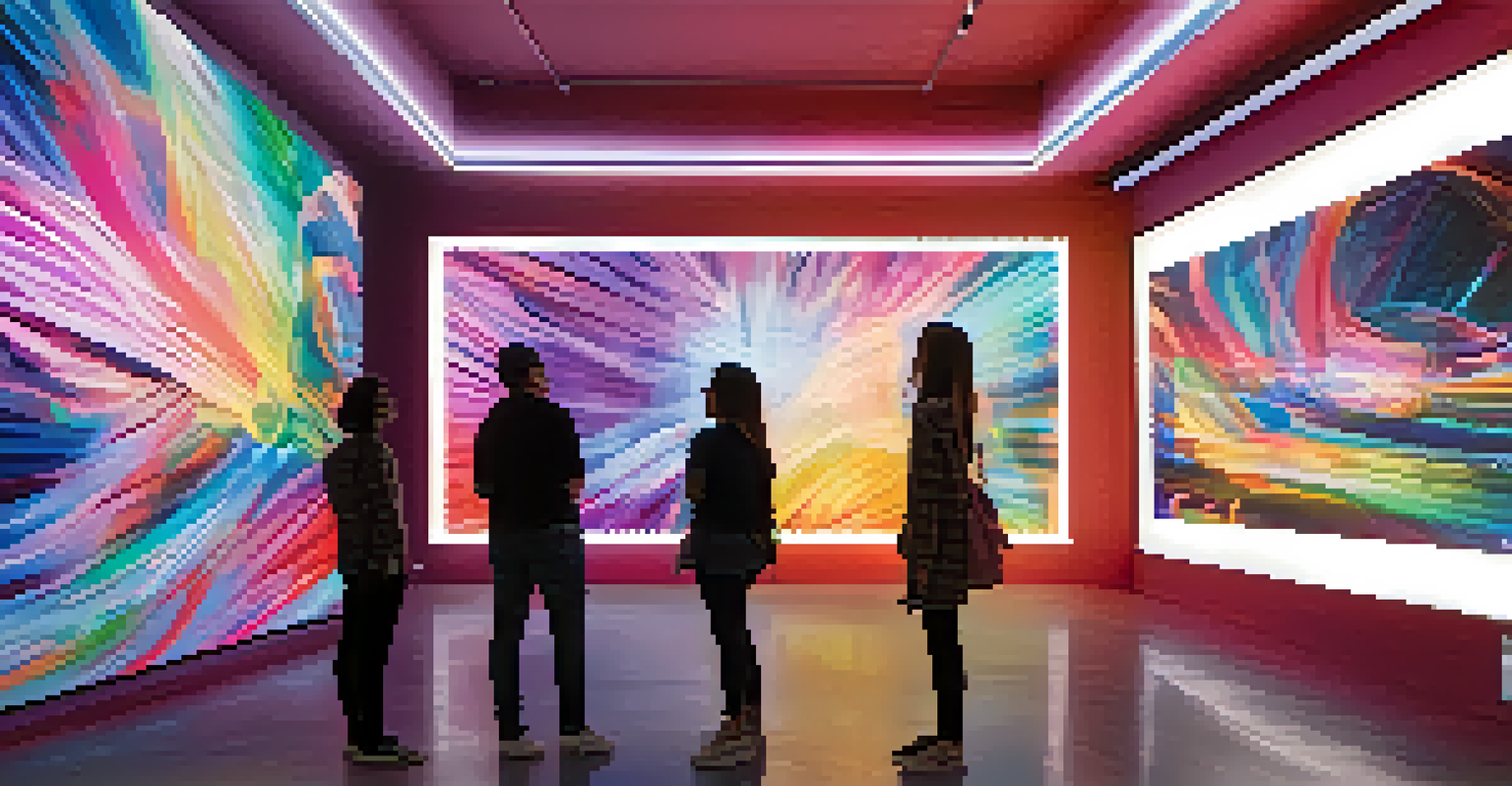Legal Challenges in Digital Art Preservation Efforts

Understanding Digital Art and Its Unique Characteristics
Digital art encompasses a wide range of works created or presented using digital technologies. Unlike traditional art forms, digital pieces can exist in various formats, including images, videos, or interactive installations. This diversity makes it difficult to apply existing legal frameworks, as they often don't consider the unique aspects of digital media.
Digital art is like a snowflake—each piece is unique, yet can be replicated endlessly without losing its essence.
One of the defining features of digital art is its reproducibility. While a painting can only exist as a single original piece, digital art can be duplicated endlessly without loss of quality. This brings about questions regarding ownership and copyright, as the traditional concepts of 'original work' may not apply in the same way, leading to potential legal disputes.
Furthermore, digital art often relies on software and platforms for creation and display, introducing additional layers of complexity. For instance, the rights associated with a piece might be entangled with the terms of service of a particular software, complicating the preservation efforts. These unique characteristics highlight the need for new legal approaches to effectively manage digital art.
Copyright Issues in Digital Art Preservation
Copyright is a critical component of protecting artistic works, but it becomes challenging in the digital realm. When an artist creates a digital piece, they automatically hold the copyright, but this can lead to confusion when it comes to sharing or preserving their work. If a digital artwork is shared without permission, the artist may face difficulty in asserting their rights.

Additionally, the concept of fair use complicates matters further. While it allows for limited use of copyrighted material without permission, determining what qualifies as fair use is often subjective. This ambiguity can deter institutions from preserving digital art, as they may fear potential legal repercussions for infringing on copyrights.
Digital Art's Unique Legal Challenges
The unique characteristics of digital art, such as reproducibility and reliance on technology, complicate traditional legal frameworks regarding ownership and copyright.
Moreover, as digital art evolves, so do the ways in which it can be reproduced and shared. With new technologies like blockchain and NFTs, artists are exploring alternative methods to establish ownership and rights. However, these innovations also raise new legal questions, making it imperative to stay informed about copyright laws in a rapidly changing digital landscape.
The Role of Licensing in Digital Art Preservation
Licensing agreements are crucial for defining how digital art can be used and shared. Artists can specify the terms under which their work can be reproduced, which helps protect their rights while allowing for preservation efforts. However, these agreements can vary widely, leading to confusion about individual rights and responsibilities.
Preservation of digital art requires a new understanding of ownership and rights in a constantly evolving landscape.
For instance, some artists might choose to release their work under Creative Commons licenses, which allow for certain uses without explicit permission. This can facilitate preservation by enabling institutions to share and display digital art more freely. However, understanding the nuances of these licenses is essential to ensure compliance and avoid legal issues.
On the flip side, overly restrictive licenses can hinder preservation efforts. If a digital artwork is locked behind stringent terms, institutions may hesitate to include it in their collections or exhibitions. Balancing the need for artist protection with the desire for broader access is a key challenge in navigating licensing for digital art.
Moral Rights and Digital Art Preservation
Moral rights protect the personal and reputational interests of artists, separate from their economic rights. These rights ensure that artists can object to modifications or uses of their work that they find objectionable. In the digital sphere, moral rights add another layer of complexity to preservation efforts, as alterations can happen easily and often without the artist's consent.
For example, if a digital artwork is displayed in a way that alters its intended message or aesthetic, the artist may feel their moral rights have been violated. This can lead to legal disputes that complicate the preservation of digital art, especially if the work is hosted on platforms that allow user modifications.
Importance of Licensing Agreements
Licensing agreements play a crucial role in defining how digital art can be shared and preserved, balancing artist rights with broader access.
Furthermore, the transient nature of digital art—often reliant on technology that may become obsolete—poses challenges for upholding moral rights. Preservation efforts must consider both the physical integrity of the work and the artist’s vision, making it essential to navigate these moral rights carefully.
Institutional Challenges in Digital Art Preservation
Institutions like museums and galleries face unique challenges in preserving digital art. Many of these organizations lack the technical expertise and resources needed to manage digital works effectively. As digital art continues to evolve, institutions must invest in training and technology to ensure they can preserve these pieces for future generations.
Moreover, the rapid pace of technological change makes it difficult for institutions to keep up. What is cutting-edge today may be outdated tomorrow, leading to concerns about the longevity of digital artworks. Institutions must not only consider the physical preservation of digital pieces but also how to adapt to ever-changing formats and platforms.
Additionally, funding for digital art preservation can be limited. Many institutions are still focused on traditional art forms, and digital works can be seen as less valuable or important. Advocating for the significance of digital art within institutional contexts is crucial to securing the necessary resources for effective preservation.
Public Domain and Digital Art Preservation Efforts
The public domain plays a significant role in digital art preservation, as works that fall into this category can be freely accessed and used. However, determining when a digital artwork enters the public domain can be complicated, especially with varying copyright laws across countries. This can lead to confusion about how and when digital art can be preserved and shared.
For instance, once copyright expires, a digital artwork can be preserved and disseminated without legal repercussions. However, the timeline for this can vary, depending on the artist's death and the specific copyright laws in place. Institutions must stay informed about these rules to effectively manage the preservation of public domain works.
Future of Digital Art Preservation
The evolving landscape of digital art requires collaboration among artists, institutions, and legal experts to navigate emerging technologies and legal challenges.
Moreover, the rise of digital art has sparked debates over what constitutes public domain in the digital age. As artists create works that incorporate existing digital content, determining ownership and copyright can become murky. Balancing the benefits of public domain access with the need to protect artists' rights is a critical conversation in the world of digital art preservation.
Future Outlook for Digital Art Preservation and Legalities
As digital art continues to gain prominence, the legal frameworks surrounding its preservation will likely evolve. Ongoing discussions about copyright, licensing, and moral rights will shape the future landscape of digital art preservation. It's essential for stakeholders—artists, institutions, and lawmakers—to engage in these conversations to create a more supportive environment for digital artists.
Emerging technologies, such as blockchain and artificial intelligence, also present new opportunities and challenges in the realm of digital art. For instance, blockchain can provide transparent ownership records, potentially simplifying copyright issues. However, it may also introduce new legal complexities that require careful consideration.

Ultimately, the future of digital art preservation hinges on collaboration among artists, institutions, and legal experts. By working together, they can navigate the legal challenges and ensure that digital art remains accessible and preserved for generations to come.